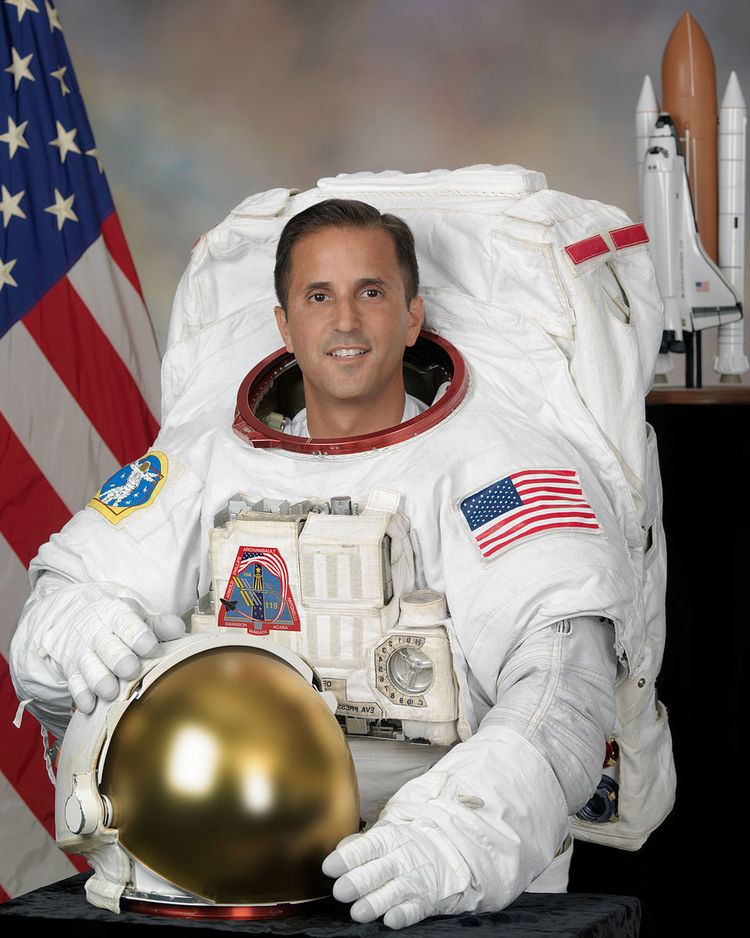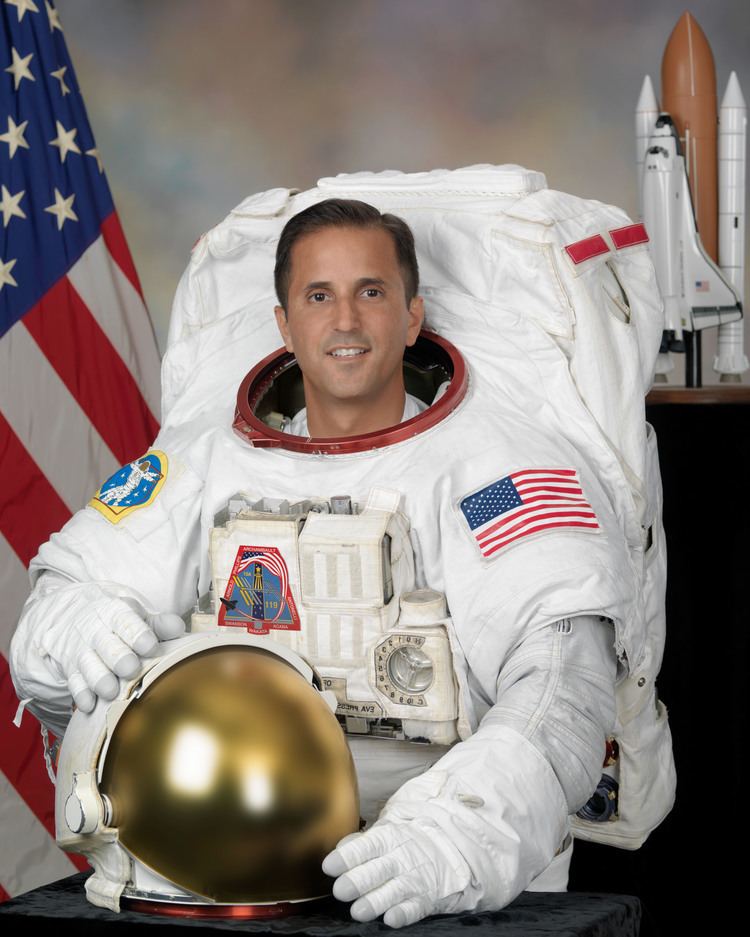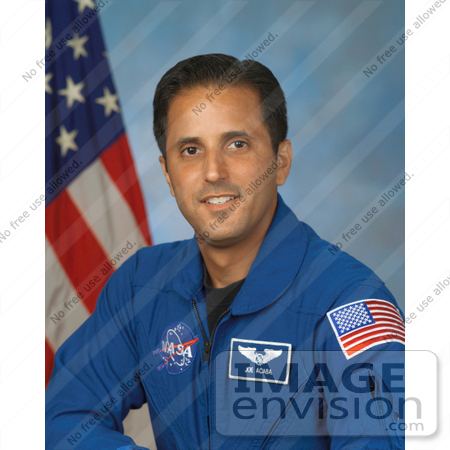Nationality American Role Educator | Name Joseph Acaba Status Active | |
 | ||
Previous occupation Hydrogeologist and teacher Time in space 137 days, 19 hours, and 22 minutes Similar People Sergei Revin, Gennady Padalka, Yuri Malenchenko, Akihiko Hoshide, Sunita Williams Profiles | ||
Entrevista con el Astronauta Joseph M. Acaba desde el Johnson Space Center.
Entrevista exclusiva a Joseph M. Acaba Full HD
Joseph Michael "Joe" Acaba (born May 17, 1967) is an educator, hydrogeologist, and NASA astronaut. In May 2004 he became the first person of Puerto Rican heritage to be named as a NASA astronaut candidate, when he was selected as a member of NASA Astronaut Training Group 19. He completed his training on February 10, 2006 and was assigned to STS-119, which flew from March 15 to March 28, 2009 to deliver the final set of solar arrays to the International Space Station. Acaba served as a Flight Engineer aboard the International Space Station, having launched on May 15, 2012. He arrived at the space station on May 17 and returned to Earth on September 17, 2012 at 6:53am Moscow Standard Time when touchdown was officially recorded by the Russian Federal Space Agency. Acaba returned to the International Space Station in 2017 as a member of Expedition 53/54.
Contents
- Entrevista con el Astronauta Joseph M Acaba desde el Johnson Space Center
- Entrevista exclusiva a Joseph M Acaba Full HD
- Early life
- Education
- NASA career
- STS 119
- Expedition 3132
- Expedition 5354
- Recognition
- References

Early life

Acaba's parents, Ralph and Elsie Acabá, from Hatillo, Puerto Rico, moved in the mid-1960s to Inglewood, California where he was born. They later moved to Anaheim, California. Since his childhood, Acaba enjoyed reading, especially science fiction. In school, he excelled in both science and math. As a child, his parents constantly exposed him to educational films, but it was the 8-mm film showing astronaut Neil Armstrong's Moon landing which really intrigued him about outer space. During his senior year in high school, Acaba became interested in scuba diving and became a certified scuba diver through a job training program at his school. This experience inspired him to further his academic education in the field of geology. In 1985, he graduated with honors from Esperanza High School in Anaheim.
Education

In 1990, Acaba received his Bachelor's degree in Geology from the University of California, Santa Barbara and in 1992, he earned his Master's degree in Geology from the University of Arizona. Acaba was a Sergeant in the United States Marine Corps Reserves where he served for six years. He also worked as a hydrogeologist in Los Angeles, California. Acaba spent two years in the United States Peace Corps and trained over 300 teachers in the Dominican Republic in modern teaching methodologies. He then served as Island Manager of the Caribbean Marine Research at Lee Stocking Island in the Exumas, Bahamas. Upon his return to the United States, Acaba moved to Florida where he became Shoreline Revegetation Coordinator in Vero Beach. He taught one year of science and math in high school and four years at Dunnellon Middle School. He also briefly taught at Melbourne High School in Melbourne, Florida. Upon his return to Earth in Fall 2012, Acaba began coursework for a Ph.D. in education from Texas Tech University through a distance learning program.
NASA career

On May 6, 2004, Acaba and ten other people were selected from 99 applicants by NASA as astronaut candidates. NASA's administrator, Sean O'Keefe, in the presence of John Glenn, announced the members of the "19th group of Astronaut Candidates", an event which has not been repeated since 1958 when the original group of astronauts was presented to the world. Acaba, who was selected as an Educator Mission Specialist, completed his astronaut training on February 10, 2006 along with the other ten Astronaut Candidates. Upon completion of his training, Acaba was assigned to the Hardware Integration Team in the International Space Station branch, working technical issues with European Space Agency (ESA) hardware.
STS-119
Acaba was assigned to the crew of STS-119 as Mission Specialist Educator, which was launched on March 15, 2009 at 7:43 p.m., after NASA engineers repaired a leaky gas venting system the previous week, to deliver the final set of solar arrays to the International Space Station. Acaba, who carried on his person a Puerto Rican flag, requested that the crew be awakened on March 19 (Day 5) with the Puerto Rico folklore song "Qué Bonita Bandera" (What a Beautiful Flag) referring to the Puerto Rican flag, written in 1971 by Florencio Morales Ramos (Ramito) and sung by Jose Gonzalez and Banda Criolla.On March 20, he provided support to the first mission spacewalk and on March 21, he performed a spacewalk in which he helped to successfully unfurl the final "wings" of the solar array that will augment power to the ISS. On March 28 the Space Shuttle Discovery and its crew of seven safely touched down on runway 15 at NASA's Kennedy Space Center in Florida at 3:14 p.m. EDT. Acaba said he was amazed at the views from the space station.
Expedition 31/32
On May 15, 2012, Acaba was one of three crew members launching from Kazakhstan aboard the Soyuz TMA-04M spacecraft to the International Space Station. He and his fellow crew members, Gennady Padalka and Sergei Revin, arrived and docked with the space station two days after launch, on May 17 at 4:36 UTC. Acaba, along with Padalka and Revin, returned to Earth on September 17, 2012, after nearly 125 days in space.
Expedition 53/54
In 2017 it was announced that Acaba would be returning to the ISS for his third mission, onboard Soyuz MS-06. The Soyuz vehicle was originally slated to launch with a crew of 2, due to the Russian crew cuts on the ISS for 2017, however at short notice it was decided that the 3rd seat would be filled by an experienced astronaut and would be funded by Roscosmos to cancel out owed debts. Acaba's backup for the mission was Shannon Walker, who should fly as prime crew on Soyuz MS-12. Acaba launched on Soyuz MS-06 on September 12, 2017, performing a 6 hour rendezvous with the ISS.
Recognition
On March 18, 2008, Acaba was honored by the Senate of Puerto Rico, which sponsored his first trip to the Commonwealth of Puerto Rico since being selected for space flight. During his visit, which was announced by then President of the Puerto Rican Senate, Kenneth McClintock, he met with schoolchildren at the Capitol, as well as at the Bayamón, Puerto Rico Science Park, which includes a planetarium and several surplus NASA rockets among its exhibits. Acaba, returned to Puerto Rico on June 1, 2009. During his visit, he was presented with a proclamation by then Governor Luis Fortuño. He spent seven days on the island and came into contact with over 10,000 persons, most of them schoolchildren. He also received the Ana G. Mendez University System Presidential Medal and a Doctorate Honoris Causa from the Polytechnic University of Puerto Rico, where he inaugurated a flight simulator on February 7, 2013 during his most recent of many visits to Puerto Rico to promote the study of math and science among students, as well as to visit his relatives. Caras Magazine named him one of the most influential and exciting Puerto Ricans of 2012.
